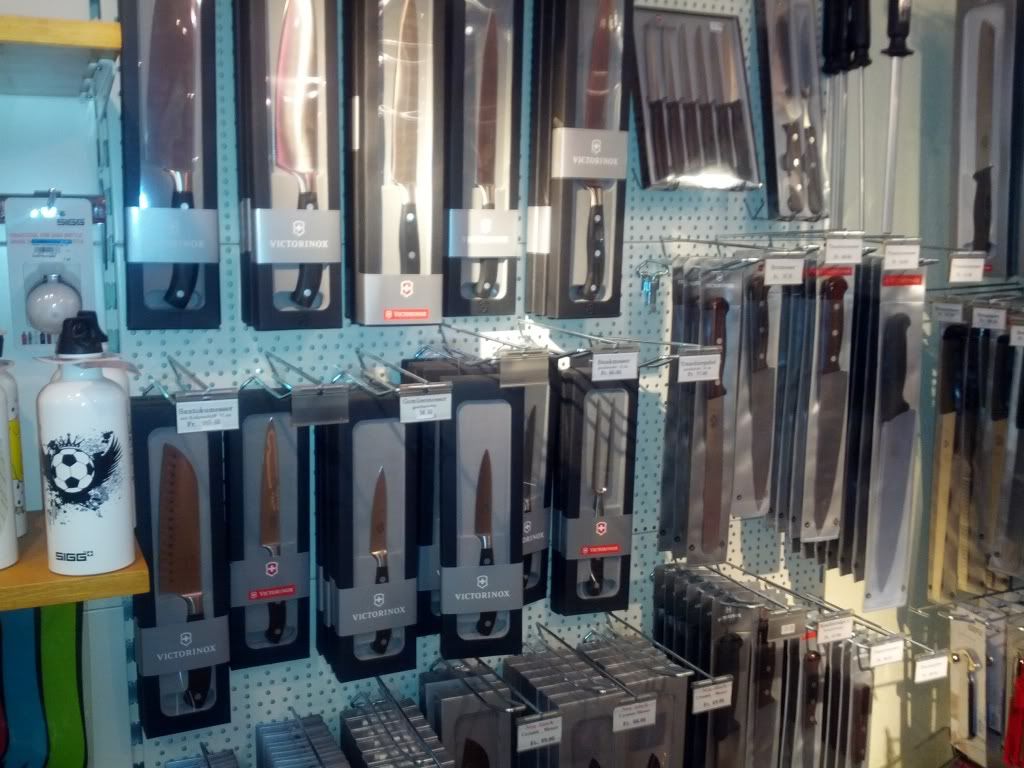Will Chan’s mods, package arrives!
Recent › Forums › Main Forum › Techniques and Sharpening Strategies › Will Chan’s mods, package arrives!
- This topic has 23 replies, 6 voices, and was last updated 04/14/2014 at 4:04 pm by
Mark76.
-
AuthorPosts
-
03/23/2014 at 3:21 am #17907
http://www.victorinox.com/ch/category/Category/Forged-Chef-s-Cutlery/2004?f=category&v=2/200/2004&m=add&
This is from the official Victorinox website otherwise go straight to the site -cutlery – forged chefs’ cutlery should get you there I am in Palma de Mallorca so I am accessing the Swiss site . I have the site in English perhaps your browser is set to Dutch and therefore it is confusing the browser.Unless you are meaning Perseval http://www.couteau.com
Leo Nav
03/25/2014 at 12:56 am #17925Leo, what a coincidence. Or perhaps not, being in Switzerland. I was walking in town and guess what I stumbled upon…
It isn’t the best picture I’ve ever made (ahum), but hopefully you can distinguish some of the knives. They are the “forged” Victorinox knives.
I held one in the hand and it felt pretty good. Also the bolster doesn’t get in the way when sharpening (though personally I’d like to see an even smaller bolster). The steel is X50CrMoV15, which is the standard for German kitchen knives. (This actually is the first time I’ve seen Victorinox disclose the steel they use. They still don’t tell you what the hardness is. :dry: ) All in all a step up from the standard Victorinox kitchen knives, I think.
What catches me is the marketing blurb of some of these manufacturers. Victorinox call these knives “forged”. Sure, what else? And according to Henckels/Zwilling their knives are “ice-hardened”. Sure, they need to be cooled after heating. (And I really really doubt whether they use ice to do so; I think oil is much more effective.)
Molecule Polishing: my blog about sharpening with the Wicked Edge
03/25/2014 at 1:07 am #17926Smart – I think I have heard of some other manufactures using ice tempering it may even be Percevel I have certainly heard of it and certainly some people temper using oil for cooling others air cooling and others water or ice.
A forged knife should be a totally different quality from either a pressed steel knife or one that is cut out of a sheet .
I have not checked out the prices of the Victorinox forged knives are they a reasonable price?Leo Nav
03/25/2014 at 1:29 am #17928Leo, what is the difference between forging and pressing? (The connotation I have with forging is a man with a hammer, but doesn’t he do in essence the same as a pressing machine?) And the sheets Victorinox pocket knives are cut from, haven’t they been forged or pressed?
The knives were reasonably priced, a bit what you’d expect for an upgraded Victorinox. In the area of the better Zwillings and Wusthoffs. I don’t recall the prices exactly, but I think a 20 cm chef knife was about CHF 120 (EUR 100) and a paring knife about CHF 50 (EUR 41).
Molecule Polishing: my blog about sharpening with the Wicked Edge
03/25/2014 at 3:51 am #17933Off the cuff when something is forged it is hammered and put back in the furnace the hammering helps to purify the metal from iron to steel the repeated heating and hammering changes the structure unifying it and strengthening it to the shape it is hammered out to it increases strength and aligns the grains in the steel or iron effectively both strengthening and purifying it .
The Japanese katanas ore both hammered and folded this hammering removes a lot of the impurities .
This is why honyakis for instance are the most superior Japanese chefs knives they are one type of steel repeatedly hammered until the shape is achieved it creates both purity and strength.
Pressing is like cutting shapes out of pastry of a uniform thickness the forged article is hammered out from a thick billet until it has the required thickness and shape.
Cheaper production blades may be press cut from a sheet (like pastry) or cut from a sheet using saws then shaping the grind with belts or wheels .
The true forged blade may be hammered either by three or four people wielding hammers in a rhythm or by a power hammer.
So as said the result is that a true forged blade is vastly superior to any other even tapping the steel with a finger nail or light solid object will give an entirely different sound to a pressed or cut blade it is much denser.
This is what i understand as the difference I am certain there are more knowledgeable people who will clarify the difference even more clearly.Leo Nav
03/25/2014 at 11:15 pm #17947I think Leo N has done a really good job of defining in lay terms the difference in production methods. I know only a little but everything I have read is spot on with what Leo N has to say. 😉
03/27/2014 at 4:49 pm #17960Leo,
How does one order these mods?
Mark
03/27/2014 at 5:02 pm #17961Send a PM to VoodooDaddy (Will Chan) and he will give you all the info you need’
Cheers
Leo04/14/2014 at 4:04 pm #18253Leo, just found this on the net: Victorinox catalogue
The brand name Wenger has now diseased…
Highlight from the catalogue for me: the Swiss army knife with a blade for soft cheeses 😉
Molecule Polishing: my blog about sharpening with the Wicked Edge
-
AuthorPosts
- You must be logged in to reply to this topic.
